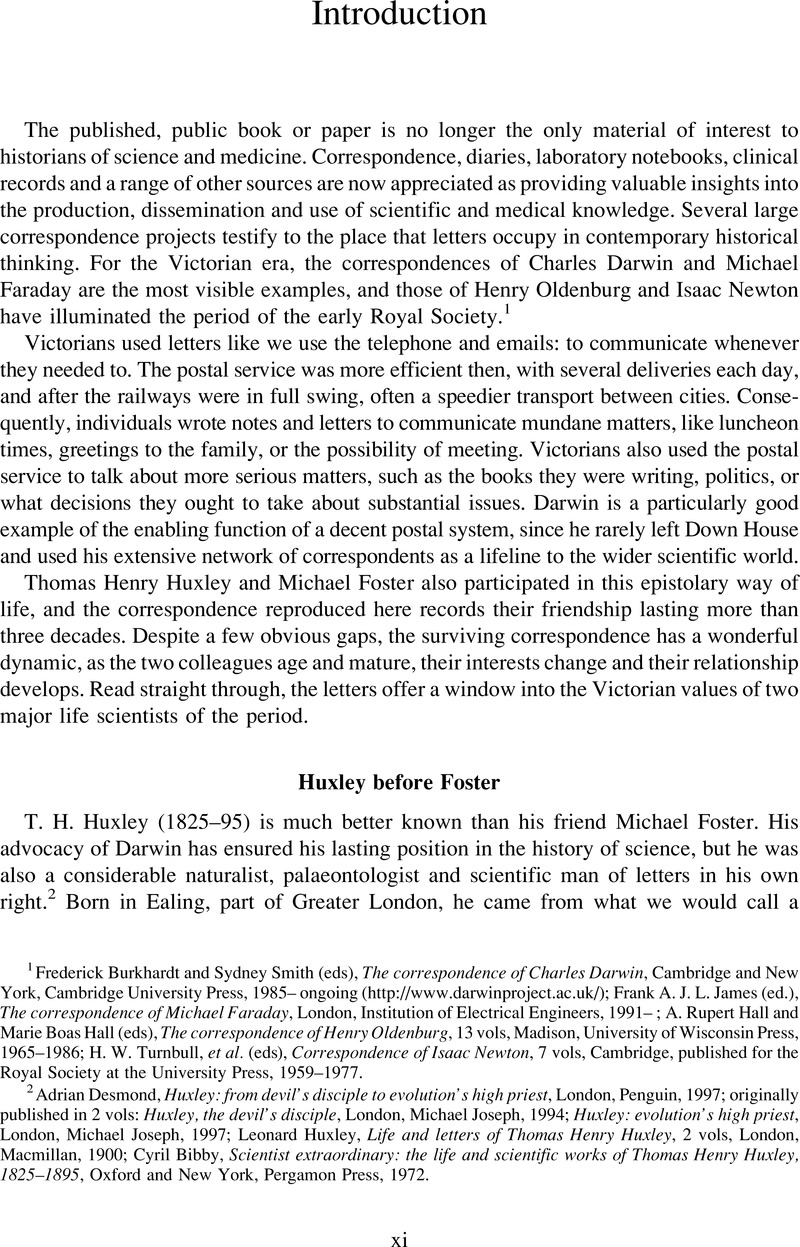No CrossRef data available.
Article contents
Introduction
Published online by Cambridge University Press: 16 November 2012
Abstract

- Type
- Introduction
- Information
- Medical History , Volume 53 , Supplement S28: Michael Foster and Thomas Henry Huxley, Correspondence, 1865–1895 , 2009 , pp. xi - xix
- Copyright
- Copyright © The Author(s) 2009. Published by Cambridge University Press
References
1 Frederick Burkhardt and Sydney Smith (eds), The correspondence of Charles Darwin, Cambridge and New York, Cambridge University Press, 1985– ongoing (http://www.darwinproject.ac.uk/); Frank A. J. L. James (ed.), The correspondence of Michael Faraday, London, Institution of Electrical Engineers, 1991– ; A. Rupert Hall and Marie Boas Hall (eds), The correspondence of Henry Oldenburg, 13 vols, Madison, University of Wisconsin Press, 1965–1986; H. W. Turnbull, et al. (eds), Correspondence of Isaac Newton, 7 vols, Cambridge, published for the Royal Society at the University Press, 1959–1977.
2 Adrian Desmond, Huxley: from devil's disciple to evolution's high priest, London, Penguin, 1997; originally published in 2 vols: Huxley, the devil's disciple, London, Michael Joseph, 1994; Huxley: evolution's high priest, London, Michael Joseph, 1997; Leonard Huxley, Life and letters of Thomas Henry Huxley, 2 vols, London, Macmillan, 1900; Cyril Bibby, Scientist extraordinary: the life and scientific works of Thomas Henry Huxley, 1825–1895, Oxford and New York, Pergamon Press, 1972.
3 T. H. Huxley, ‘On a hitherto undescribed structure in the human hair sheath’, London Medical Gazette, 1845, 36: 1340–1.
4 T. H. Huxley, The oceanic Hydrozoa: a description of the Calycophoridæ and Physophoridæ observed during the voyage of H.M.S. “Rattlesnake,” in the years 1846–1850, with a general introduction, London, printed for the Ray Society, 1859.
5 Peter Alter, The reluctant patron: science and the state in Great Britain, 1850–1920, transl. Angela Davies, Leamington Spa, Berg, 1986.
6 There are discussions of the debate in Desmond, op. cit., note 2 above, pp. 278–81, and Janet Browne, Charles Darwin, vol. 2, The power of place, London, Jonathan Cape, 2002, pp. 120–8.
7 See Frank Turner, Between science and religion: the reaction to scientific naturalism in late Victorian England, New Haven, Yale University Press, 1974, and Bernard Lightman, Evolutionary naturalism in Victorian Britain: The ‘Darwinians’ and their critics, Aldershot, Ashgate, 2009. For Huxley's biological teaching, see Cyril Bibby, T. H. Huxley: scientist, humanist, and educator, London, Watts, 1959, and Robert G. B. Reid, ‘Thomas Henry Huxley and nineteenth-century biology’, in Alan P. Barr (ed.), Thomas Henry Huxley's place in science and letters, Athens, GA, University of Georgia Press, 1997, pp. 182–212.
8 Thomas H. Huxley, Collected essays, 9 vols, London, Macmillan, 1893–1894.
9 Randal Keynes, Annie's box: Charles Darwin, his daughter and human evolution, London, Fourth Estate, 2001.
10 The fullest account of Foster's life and career remains the pioneering monograph by Gerald Geison, Michael Foster and the Cambridge School of Physiology: the scientific enterprise in late Victorian society, Princeton, Princeton University Press, 1978.
11 Geison, ibid., analyses this in some detail. On research schools more generally, see Gerald L. Geison and Frederic L. Holmes (eds), Research schools: historical reappraisals, Osiris, 2nd ser., 1993: 8.
12 In addition to the discussion by Desmond and other biographers of this episode in Huxley's life, see Marie Boas Hall, All scientists now: the Royal Society in the nineteenth century, Cambridge and New York, Cambridge University Press, 1984.
13 The only full-length biography of Lankester – Joseph Lester, E. Ray Lankester and the making of modern British biology, ed. Peter J. Bowler, Faringdon, Oxon, British Society for the History of Science, 1995 – is helpful but clearly not the last word on this important but shadowy biologist.
14 In addition to Alter and Hall, see especially the essays of Roy MacLeod, collected into two Variorum editions, Public science and public policy in Victorian England, Brookfield, VT, Variorum, 1995 and The “creed of science” in Victorian England, Aldershot, and Burlington, VT, Ashgate / Variorum, 2000. See also Roy M MacLeod, ‘The Royal Society and the government grant: notes on the administration of scientific research, 1849–1914’, Historical Journal, 1971, 14: 323–58.
15 For Dohrn, see Theodor Heuss, Anton Dohrn: a life for science, transl. Liselotte Dieckmann, ed. Christiane Groeben, Berlin and New York, Springer, 1991; also published volumes of correspondence such as Christiane Groeben (ed.), Charles Darwin 1809–1882, Anton Dohrn 1840–1909: correspondence, Naples, Macchiaroli, 1982; and Christiane Groeben (ed.), Correspondence, Karl Ernst von Baer (1792–1876), Anton Dohrn (1840–1909), transl. Christiane Groeben and Jane M. Oppenheimer, Philadelphia, American Philosophical Society, 1993.
16 The literature on the Marine Biological Association is relatively sparse, but see A. J. Southward and E. K. Roberts, The Marine Biological Association, 1884–1984: one hundred years of marine research, Plymouth, Marine Biological Association, 1984, and Joseph Lester, E. Ray Lankester and the making of modern British biology, ed. Peter J. Bowler, Faringdon, Oxon, British Society for the History of Science, 1995.
17 Margaret Deacon, Scientists and the sea, 1650–1900, 2nd ed., Aldershot, Ashgate, 1997.
18 See Philip F. Rehbock, ‘Huxley, Haeckel, and the oceanographers: the case of Bathybius haeckelii’, Isis, 1975, 66: 504–33, and Desmond, op. cit., note 2 above, p. 460.




